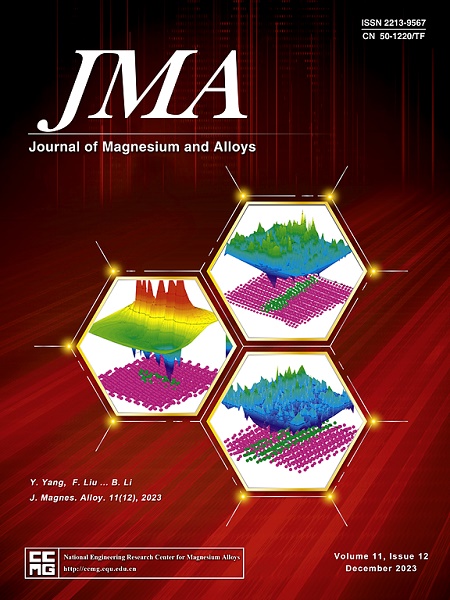一种用于可充电镁电池的基于全无机盐的无调节特性的非亲核电解质
IF 15.8
1区 材料科学
Q1 METALLURGY & METALLURGICAL ENGINEERING
引用次数: 0
摘要
具有高镁电镀/剥离可逆性的无调理电解质对于优质可充电镁电池(RMB)的商业化至关重要。本研究以氯化镁、氯化锂和氯化铬的无机盐为基础,通过简单的一步反应制备了一种用于人民币的非亲核电解质(简称 MLCH)。因此,MLCH 电解液具有高离子电导率(3.40 mS cm-1)、低过电位(对 Mg/Mg2+ ∼ 46 mV)、高库仑效率(∼ 93%)、高阳极稳定性(SS,对 Mg/Mg2+ ∼ 2.56 V)和长期(超过 500 h)循环稳定性等显著性能,尤其是无调理特性。经证实,MLCH 电解质中的主要平衡物种是[LiCl2(THF)2]-的四配位阴离子和[Mg2(µ-Cl)3(THF)6]+的溶解二聚体。氯化锂的加入有助于氯化镁的溶解和电极/电解质界面的活化,从而提高镀镁/剥离效率。LiCl、CrCl3 和少量 HpMS 的协同作用以及不含聚合 THF 使 MLCH 电解质具有无调节特性。此外,MLCH 电解质还与 CuS 阴极材料具有良好的兼容性。使用 MLCH 电解质的 Mg/CuS 全电池在 0.1 C 时的放电比容量为 215 mAh g-1,循环 40 次后容量仍能保持在 72% 左右。值得注意的是,MLCH 电解质还具有材料来源广泛、成本低廉、易于制备等优点,具有潜在的商业应用前景。本文章由计算机程序翻译,如有差异,请以英文原文为准。
A non-nucleophilic electrolyte based on all-inorganic salts with conditioning-free characteristic for rechargeable magnesium batteries
Conditioning-free electrolytes with high reversibility of Mg plating/stripping are of vital importance for the commercialization of the superior rechargeable magnesium batteries (RMBs). In the present work, a non-nucleophilic electrolyte (denoted as MLCH) based on all-inorganic salts of MgCl2, LiCl and CrCl3 for RMBs is prepared by a straightforward one-step reaction. As a result, the MLCH electrolyte shows the noticeable performance of high ionic conductivity (3.40 mS cm−1), low overpotential (∼46 mV vs Mg/Mg2+), high Coulombic efficiency (∼93%), high anodic stability (SS, ∼2.56 V vs Mg/Mg2+) and long-term (more than 500 h) cycling stability, especially the conditioning-free characteristic. The main equilibrium species in the MLCH electrolyte are confirmed to be the tetracoordinated anions of [LiCl2(THF)2]− and solvated dimers of [Mg2(µ-Cl)3(THF)6]+. The addition of LiCl can assist the dissolution of MgCl2 and activation of the electrode/electrolyte interface, resulting in a superior Mg plating/stripping efficiency. The synergistic effect of LiCl, CrCl3, a small amount of HpMS and the absence of polymerization THF enable the conditioning-free characteristic of the MLCH electrolyte. Moreover, the MLCH electrolyte exhibits decent compatibility with the cathodic materials of CuS. The Mg/CuS full cell using the MLCH electrolyte presents a discharge specific capacity of 215 mAh g−1 at 0.1 C and the capacity can retain ∼72% after 40 cycles. Notably, the MLCH electrolyte has other superiorities such as the broad sources of materials, low-cost and easy-preparation, leading to the potential prospect of commercial application.
求助全文
通过发布文献求助,成功后即可免费获取论文全文。
去求助
来源期刊

Journal of Magnesium and Alloys
Engineering-Mechanics of Materials
CiteScore
20.20
自引率
14.80%
发文量
52
审稿时长
59 days
期刊介绍:
The Journal of Magnesium and Alloys serves as a global platform for both theoretical and experimental studies in magnesium science and engineering. It welcomes submissions investigating various scientific and engineering factors impacting the metallurgy, processing, microstructure, properties, and applications of magnesium and alloys. The journal covers all aspects of magnesium and alloy research, including raw materials, alloy casting, extrusion and deformation, corrosion and surface treatment, joining and machining, simulation and modeling, microstructure evolution and mechanical properties, new alloy development, magnesium-based composites, bio-materials and energy materials, applications, and recycling.
 求助内容:
求助内容: 应助结果提醒方式:
应助结果提醒方式:


